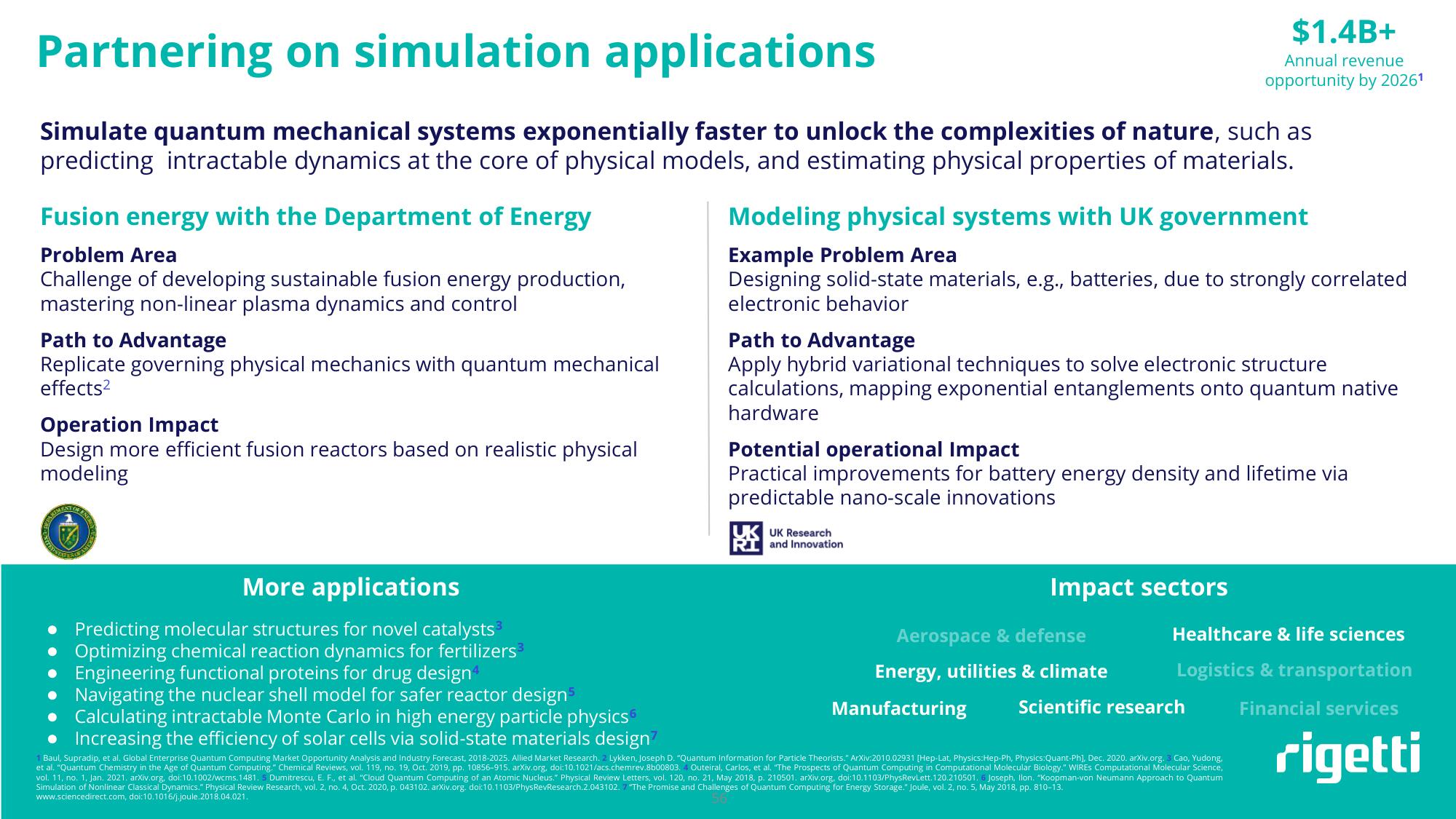Rigetti SPAC Presentation Deck
Partnering on simulation applications
Simulate quantum mechanical systems exponentially faster to unlock the complexities of nature, such as
predicting intractable dynamics at the core of physical models, and estimating physical properties of materials.
Fusion energy with the Department of Energy
Problem Area
Challenge of developing sustainable fusion energy production,
mastering non-linear plasma dynamics and control
Path to Advantage
Replicate governing physical mechanics with quantum mechanical
effects²
Operation Impact
Design more efficient fusion reactors based on realistic physical
modeling
PARA ENER
TEPST
RUPAME
More applications
• Predicting molecular structures for novel catalysts³
Optimizing chemical reaction dynamics for fertilizers³
• Engineering functional proteins for drug design4
•
Navigating the nuclear shell model for safer reactor design5
Calculating intractable Monte Carlo in high energy particle physics
Increasing the efficiency of solar cells via solid-state materials design7
Modeling physical systems with UK government
Example Problem Area
Designing solid-state materials, e.g., batteries, due to strongly correlated
electronic behavior
Path to Advantage
Apply hybrid variational techniques to solve electronic structure
calculations, mapping exponential entanglements onto quantum native
hardware
Potential operational Impact
Practical improvements for battery energy density and lifetime via
predictable nano-scale innovations
UK Research
and Innovation
$1.4B+
Annual revenue
opportunity by 20261
Impact sectors
Aerospace & defense
Energy, utilities & climate
Manufacturing
Healthcare & life sciences
Logistics & transportation
Financial services
Scientific research
1 Baul, Supradip, et al. Global Enterprise Quantum Computing Market Opportunity Analysis and Industry Forecast, 2018-2025. Allied Market Research. 2 Lykken, Joseph D. "Quantum Information for Particle Theorists." ArXiv:2010.02931 [Hep-Lat, Physics:Hep-Ph, Physics:Quant-Ph], Dec. 2020. arXiv.org. 3 Cao, Yudong,
et al. "Quantum Chemistry in the Age of Quantum Computing." Chemical Reviews, vol. 119, no. 19, Oct. 2019, pp. 10856-915. arXiv.org, doi:10.1021/acs.chemrev.8b00803. 4 Outeiral, Carlos, et al. "The Prospects of Quantum Computing in Computational Molecular Biology." WIRES Computational Molecular Science,
vol. 11, no. 1, Jan. 2021. arXiv.org, doi:10.1002/wcms.1481. 5 Dumitrescu, E. F., et al. "Cloud Quantum Computing of an Atomic Nucleus." Physical Review Letters, vol. 120, no. 21, May 2018, p. 210501. arXiv.org, doi:10.1103/PhysRevLett. 120.210501. 6 Joseph, Ilon. "Koopman-von Neumann Approach to Quantum
Simulation of Nonlinear Classical Dynamics." Physical Review Research, vol. 2, no. 4, Oct. 2020, p. 043102. arxiv.org. doi:10.1103/PhysRevResearch.2.043102. 7 "The Promise and Challenges of Quantum Computing for Energy Storage." Joule, vol. 2, no. 5, May 2018, pp. 810-13.
www.sciencedirect.com, doi:10.1016/j.joule.2018.04.021.
rigettiView entire presentation